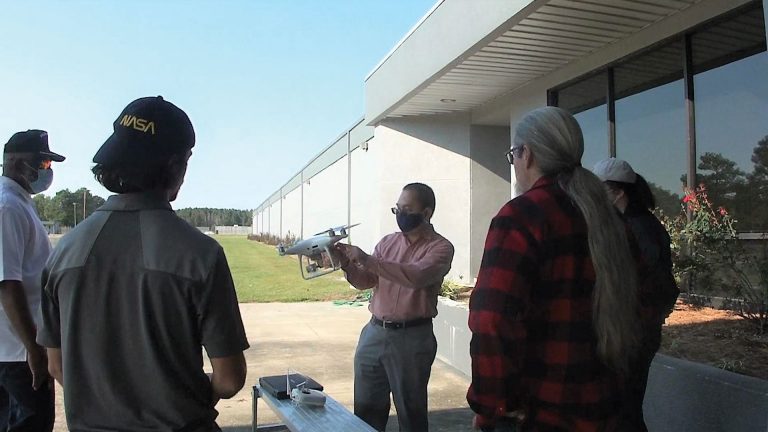At Fayetteville State University (FSU) in North Carolina, geography is arguably one of the most popular minors. In large part, that’s thanks to Dr. Adegoke Ademiluyi, professor of geography in the Department of Intelligence Studies, Geospatial Science, Political Science and History. Four years ago, he undertook several initiatives to turn geospatial education into a high-profile degree program.
Unfortunately, the COVID-19 pandemic threatens to derail the progress that Ademiluyi and his colleagues have made. In response to its own diminishing budget, the State of North Carolina in July asked all schools within the University of North Carolina (UNC) system—of which FSU is a part—to submit contingency plans for dealing with deep budget cuts that would likely go into effect in the 2020–2021 academic year. Any significant cuts inevitably trickle down to degree programs. So external funding becomes critical to supporting program activities—especially those that enhance students’ technical competencies in subjects such as GIS.

When the American Association of Geographers (AAG) started its Bridging the Digital Divide program, which aids students with technology needs during the COVID-19 pandemic, and offered its first round of funding, Ademiluyi was among the geography faculty members to respond. (See “A Starting Point for Bridging the Digital Divide” on page 23 for more on this.) This has enabled Ademiluyi to purchase laptops and adequate GIS software for his students. He wants to do more, though, including support off-campus Wi-Fi access and purchase additional laptops that could be loaned to students who need them each semester. That will require more funding.
The AAG’s senior geography researcher Coline Dony caught up with Ademiluyi to talk about FSU’s geospatial programs and how they have been affected by COVID-19. The interview that follows has been lightly edited for clarity.
Dony (D): How has your program evolved to incorporate GIS studies?
Ademiluyi (A): The geography program began in 1979 and awarded its first baccalaureate degree in 1984. By 2010, facing declining enrollment numbers, a GIS expert was brought in to lead a program overhaul. The purpose was not only to boost the numbers but also to ensure that each graduate acquires career-ready technical competencies upon exiting the program.
Today, 10 years later, the program has three faculty members, including two GIS professionals, and a rapidly growing and highly motivated base of undergraduate majors and geospatial certificate seekers. The undergraduate certificate program in geospatial intelligence is something we added. It is certified by the United States Geospatial Intelligence Foundation (USGIF) and offered in collaboration with two other academic programs: intelligence studies and computer science. We also now offer a minor in geospatial intelligence.
In addition, we established a full-fledged laboratory facility in fall 2010 that’s funded by the US National Geospatial-Intelligence Agency (NGA). The NGA also supports faculty development, student stipends, and scholarships.
More than 60 percent of the required courses in our program are now taught using GIS. We plan to introduce courses in drone technology (with equipment funded by the US Department of Defense) and advanced remote sensing technology. This fall, we changed the formal name of the degree program from a BA in geography to a BA in geospatial science to better reflect the courses’ strong GIS technology component. Our students still get a well-rounded grounding in geography, though, with required classes such as Principles of Geography and new classes like Spatial Thinking and Data Visualization. This allows them to gain a deeper understanding of fundamental geographic concepts and helps explain geographic processes.
Over the last two years, the program has enjoyed a fourfold increase in enrollment, especially in the certification program. Continuing growth in the degree program itself is expected as soon as these new courses are deployed and accessible to students, wherever they may be.
D: How has the COVID-19 pandemic affected your work as a GIS instructor and your students’ ability to learn?
A: COVID-19 has dramatically affected overall attendance because of the need to take precautions, given that many students have high-risk family members. Since students learn GIS techniques at different paces, it is extremely difficult to ensure that all students get the proper instruction they need when they are not in class. This lack of instruction can make students stressed and confused, which sometimes results in poor class participation.
Learning GIS techniques is not only about the interaction between instructor and student but also about students’ ability to interact with one another. When students cannot attend class in person, they miss out on that valuable interaction time. Students can’t help one another as effectively as they could face-to-face. This has led to students being lost when it comes to understanding the material, which can cause them to turn in assignments late or result in an overall dearth of engagement.
D: You have argued for using funds to let students purchase their own laptops rather than borrowing equipment. Why?
A: Remote learning has completely altered the concept of loaning school equipment to students for home use. We know that completing GIS tutorials and assignments takes more than the two or three hours of class time students have each week. We also know that it takes approximately five hours for someone with experience to complete the task. For someone who is new to GIS, it could take longer. Brief equipment loans here and there won’t suffice.
Students also must complete tutorials and assignments. They need a computer that’s capable of handling the GIS software they use (in many cases, ArcGIS Desktop). With so many of us working from home already, the boundaries of school and home are blurred. Add to this the fact that many FSU students come from low-income families that cannot afford a computer that can handle the GIS software. Being able to own the proper equipment and keep it at all times can help students feel less overwhelmed and better ensures that they can participate in the class and the full program.
Due to strict campus guidelines during COVID-19, our students do not have access to the GIS lab outside classroom hours unless an instructor is present. While students can book these additional lab hours, what works for the instructor might not work for the student. Many of our students have families or are employed outside the university. They do not always have time to show up for additional lab hours, even if those are available. That’s another reason student ownership of equipment is so important.
D: If you had more funding, how many laptops would you need to successfully fund the spring 2021 semester, and how would your program go about distributing or loaning out the laptops effectively and efficiently?
A: We are grateful to the AAG and Esri for this opportunity to create a laptop rental system in our GIS program. The current program is patterned after our institution’s book rental system, though there are some key differences. Each student is guaranteed access to textbooks for all their classes, and books must be returned at the completion of each course. Our current laptop rental system, however, is on more of a need-to-use and when-available basis.
For spring 2021, I would like to enable students to keep the laptops as long as they are enrolled in the degree or certificate program. We can also build in an incentive that would allow students to keep their laptops after graduation. That alone could encourage more students—who might not do so otherwise—to explore our program’s offerings, since proficiency in GIS and its applications is seen as such a highly technical enterprise, especially in liberal arts institutions. Such an inducement would not only promote interest in GIS across FSU, but it would also make the program more attractive to a whole new range of talented students.

